Dmv practice test 1-12
1/83
There's no tags or description
Looks like no tags are added yet.
Name | Mastery | Learn | Test | Matching | Spaced |
|---|
No study sessions yet.
84 Terms
Which of the following is a dangerous habit when driving in work zones?
Tailgating another vehicle & Failing to carefully watch for workers and moving equipment
If weather or light conditions require you to have your lights on while driving:
Use your low beams.
When you are merging onto the freeway, you should be driving:
At or near the speed of traffic on the freeway
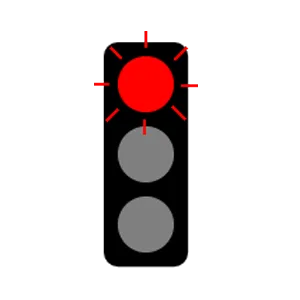
If you approach a flashing red traffic light, you:
Must treat the intersection as if it is controlled by a stop sign.
You are approaching an intersection where a traffic signal is displaying a steady yellow light. If you have not already entered the intersection, you should:
Come to a safe stop.
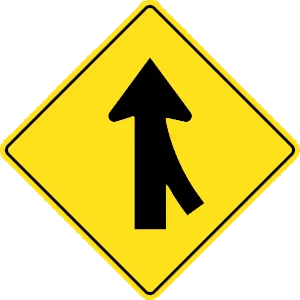
This yellow sign means:
Merging traffic ahead.
To enter a gap in highway traffic:
Check behind you, then watch the vehicle ahead.
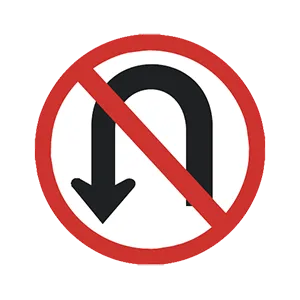
This sign means:
No U-turn.
Streets and highways are most slippery:
Just after it starts to rain
When driving at night, you should:
Increase your following distance.
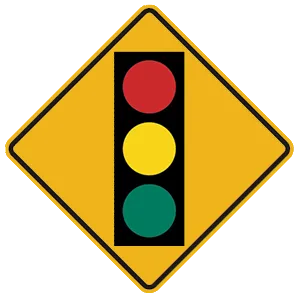
This sign means:
Traffic signal ahead.
Which of the following statements is true?
Driving too slowly on certain highways can be dangerous.
It is necessary to use your low beams any time you are:
In fog.
If your car becomes disabled while on the highway, you should:
Park with all four wheels off the traveled highway, if possible.
If you park facing uphill where there is no curb, set the parking brake and:
Turn your wheels toward the edge of the road.
Which of these statements is true about changing lanes?
Look over your right shoulder for a right lane change and your left shoulder for a left lane change.
In a work zone:
Traffic patterns can change daily.
Temporary signs used in construction and maintenance work areas:
Have an orange background with black writing.
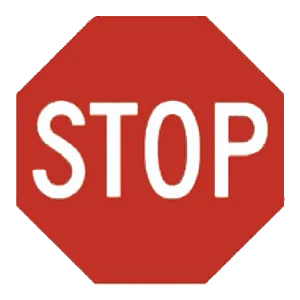
This road sign means:
You must come to a complete stop.
In which of the following scenarios should your wheels not be pointed straight ahead?
When parked on a hill or sloping driveway.
When preparing to make a left turn from a two-way street, you should drive:
Near the centerline
At an intersection with stop signs on all corners, yield the right-of-way to any driver:
Who arrived before you.
You are entering a freeway. Check traffic on the freeway by:
Using your side mirror and looking over your shoulder.
To help others see you when daylight begins to fade, you should use your:
Low beam headlights.
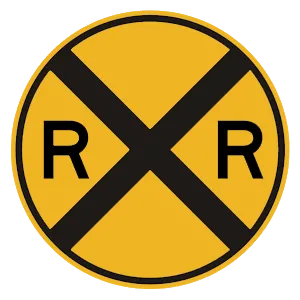
What should you do when you see this sign?
Slow down and yield to trains.
As you approach the top of a hill, you should:
Prepare to stop, if needed.
If your vehicle begins to skid, you should:
Ease up on the gas pedal.
Stopping distances and the severity of collisions:
Increase as a vehicle's speed increases.
When you are facing a green light and there are pedestrians in the intersection:
You must yield the right-of-way to pedestrians.
You want to turn left at an upcoming corner. Yield the right-of-way to:
All approaching vehicles.
If a tire suddenly blows out while you are driving, you should:
Grip the steering wheel firmly, slow down, and exit the traffic lane.
When may you legally drive around or under a railroad crossing gate?
Never.
If you come to an intersection controlled by a flashing yellow light, you must:
Slow down and cross the intersection carefully.
If you approach a stopped school bus that has its lights flashing and signal arm extended, you should:
Stop
To be able to turn quickly, your hands must be:
On opposite sides of the steering wheel.

This road sign means:
Lane reduction. The right lane ends soon and traffic should merge left.
To pass on a two-lane road, you should:
judge the distance to any oncoming vehicles.
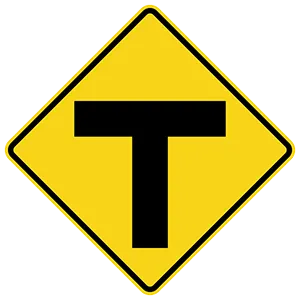
This sign shows one type of:
Intersection.
When changing lanes, you should never:
Change lanes abruptly or spontaneously.
A large truck is ahead of you and is turning right onto a street with two lanes in each direction. The truck:
May have to swing wide to complete the right turn.
You can help keep the driver behind you a safe distance away from your vehicle by:
Maintaining a steady speed
When driving in fog, it is best to drive with:
Low beam headlights.
When driving on a slippery surface, such as snow or ice:
Shift to a low gear before going down steep hills.
The driver ahead of you stops at a crosswalk. What should you do?
Stop, proceeding only when all the pedestrians have crossed.
Roads are slippery after it first starts to rain. When the road is slippery, you should:
Avoid making turns and stops while driving at high speeds.
Make room for cars that are entering the freeway by:
Merging into a different lane.
A driver should:
Watch beside, ahead, and to the rear of their car.
You may not park within how many feet of a stop sign?
25 feet
If you are about to be hit from the rear, you should consider each of the following, except for:
Letting go of the steering wheel.
When a pedestrian guided by a dog or carrying a white cane is crossing the street:
You must always yield the right-of-way.
If your car begins to skid out of control, you should:
Stay off the brakes.
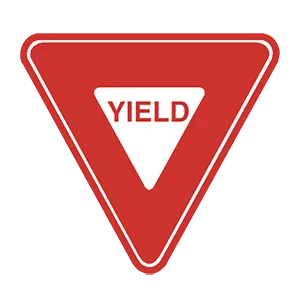
This sign means:
Yield the right-of-way.
If you are driving and a tire suddenly goes flat, you should:
Slow down gradually and not brake.
Which of these statements is true about drinking alcohol and driving?
Alcohol affects judgement, which is needed to drive safely.
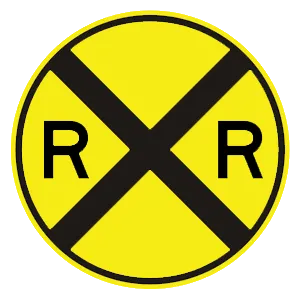
This sign indicates a:
Railroad crossing.
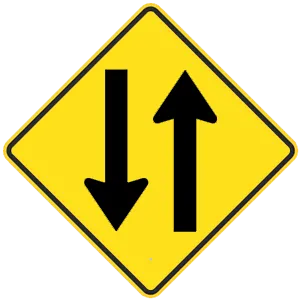
This sign means:
Two-way traffic ahead.
If you are being passed in a no passing zone, you should:
Slow down and let the other driver safely return to the drive lane.
Prior to entering a curve:
Reduce your speed.
If you are arrested for a first time DUI offense and you refuse to take a breath test, your license will be suspended for at least:
45 days.
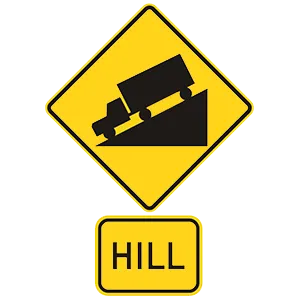
This sign indicates that:
There is a steep hill ahead.
There is no crosswalk and you see a pedestrian crossing your lane ahead. You should:
Stop and let the pedestrian finish crossing the street.
Slowing down just to look at collisions or anything else out-of-the-ordinary:
Causes traffic congestion.
When turning left at an intersection:
You should always yield to oncoming traffic and pedestrians.
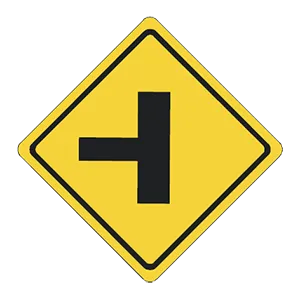
This sign means:
Side road.
You may cross double yellow lines to pass another vehicle if the:
Yellow line next to your side of the road is broken.

Signs with orange backgrounds are:
Construction and maintenance warning signs.
On a green arrow, you must:
Yield to any vehicle, bicycle, or pedestrian in the intersection.
Interstate driving requires drivers to:
Have the ability to safely drive at increased speeds & Be constantly alert.
When driving in work zones, you should:
Reduce your speed and be prepared to stop suddenly.
You must show proof of insurance to law enforcement:
If you are involved in a collision or stopped for a citation.
Drivers who are 16 or 17 years of age are not permitted to use any type of:
Cell phone & Text messaging device
When approaching an intersection with a flashing red light, you must:
Come to a complete stop, yield to oncoming traffic and pedestrians, then proceed.
If you plan to pass another vehicle, you should:
Not assume the other driver will make space for you to return to your lane
It is dangerous to follow a motorcycle too closely because:
A motorcycle can stop much faster than a standard vehicle.
Vehicles stopped behind a school bus with its red lights flashing must remain stopped until:
The stop arm is retracted and the bus resumes motion.
Signs and lane markings that indicate a no passing zone tell you that:
You cannot see far enough ahead to pass safely.
While driving at night, a vehicle coming toward you has its high beams on, making it hard for you to see the road ahead. You should:
Look ahead toward the right edge of your lane.
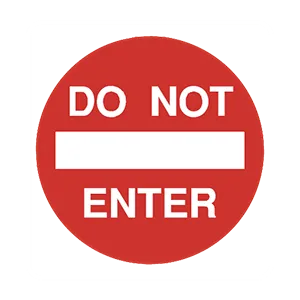
This sign means:
Do not enter.
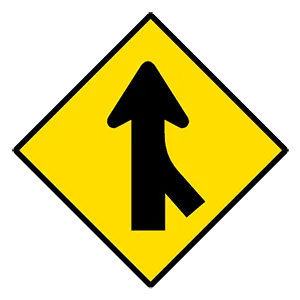
This sign means:
Merging traffic from the right.